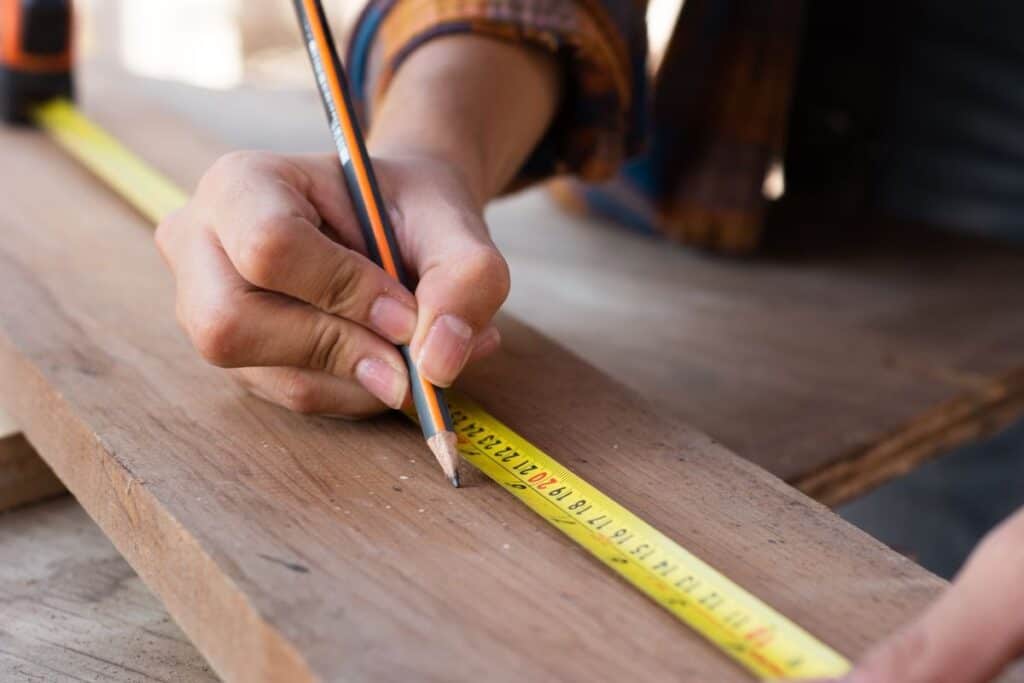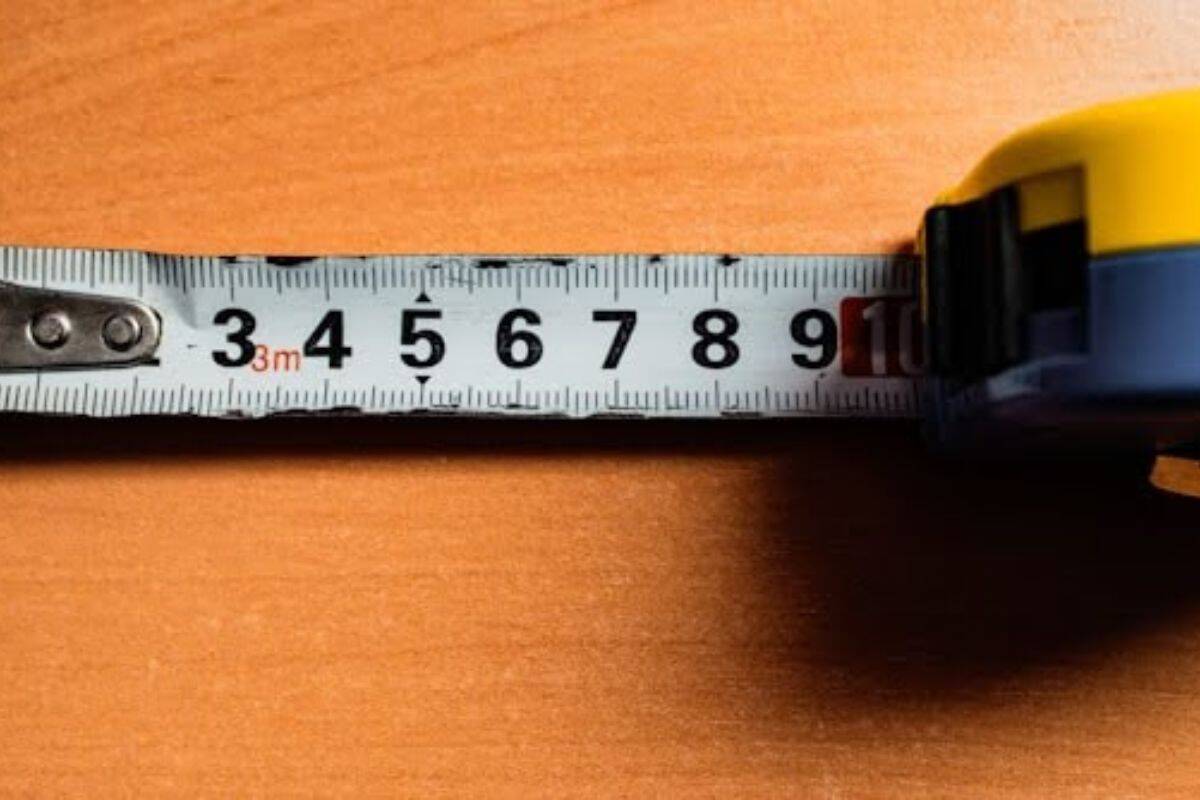You are likely to have seen something that is in meters and wondered to yourself, “How many feet is that?” Well, you are not the only one.
Converting measurements is a daily challenge, whether you are doing it while shopping, working on a home project, or simply trying to check if that 3-meter ceiling will fit your new bookshelf.
The positive thing is that conversion is much easier than you imagine. Once you understand the basic formula or have a handy conversion chart.
You are good to go.
Key Takeaways
- 1 Meter = 3.28084 feet
- The metric and imperial systems are the two types of measurement systems
- You need to know when to multiply or divide when converting
Metric vs Imperial: Quick Overview
As far as measurement is concerned, there are two systems, the Metric and the Imperial system.
The metric system consists of meters, centimeters, and kilometers. The imperial system consists of feet, inches, and miles.
Nearly the entire world uses the metric system which is typically based on units of ten, i.e., the decimal system. It is also considered a simpler method for conversion.


Never Worry About AI Detecting Your Texts Again. Undetectable AI Can Help You:
- Make your AI assisted writing appear human-like.
- Bypass all major AI detection tools with just one click.
- Use AI safely and confidently in school and work.
The imperial system, on the other hand, is mostly used in the United States. In the US, feet and inches are used for everything from measuring rooms to describing a person’s height.
Converting metrics involves multiplying and dividing by powers of ten. However, converting imperials is less straightforward. With imperials, you need specific conversion factors.
The Exact Conversion Formula
The exact conversion formula is actually simple. All you have to do is multiply the meters by 3.28084, and you will have your results in feet.
Also, if you want to convert back to meters, you have to divide whatever feet by 3.28084.
1 Meter = 3.28084 Feet
When converted, one meter is 3.28084 feet.
This is an absolute value, though other people simply round it to 3.28 or 3.3 so that they can make some quick calculations and conversions in their head.
How to Multiply Meters by 3.28084
You don’t have to be a maths guru to do this. It is simple maths. When you have learned the number of feet in one meter, you are good to go.
This is how to multiply meters:
Just round up 3.28084 to 3.28 or 3.3 and multiply. You can also use a calculator.
All you need to do is to key in how many meters and multiply by the entire 3.28084. e.g.: 2 meters x 3.28084 = 6.56168 feet or 6.6 feet when rounding up.
Example Calculations (1m, 5m, 10m, etc.)
Here are common conversion calculations:
- 1 Meter to Feet: 1 × 3.28084 = 3.28084 feet
- 3 Meters to Feet: 3 × 3.28084 = 9.84252 feet
- 5 Meters to Feet: 5 × 3.28084 = 16.4042 feet
- 10 Meters to Feet: 10 × 3.28084 = 32.8084 feet
- 15 Meters to Feet: 15 × 3.28084 = 49.2125feet
- 20 Meters to Feet: 20 × 3.28084 = 65.6168 feet
Quick Conversion Chart: Meters to Feet
This is a quick conversion chart of meters to feet
Table: 0.5m to 100m
| Meters | Feet |
| 0.5 | 0.6 |
| 1 | 3.3 |
| 5 | 16.4 |
| 10 | 32.8 |
| 15 | 49.2 |
| 20 | 65.6 |
| 25 | 82.0 |
| 30 | 98.4 |
| 35 | 114.8 |
| 40 | 132.2 |
| 45 | 147.6 |
| 50 | 164.0 |
| 55 | 180.4 |
| 60 | 196.6 |
| 65 | 213.3 |
| 70 | 229.7 |
| 75 | 246.1 |
| 80 | 262.5 |
| 85 | 272.9 |
| 90 | 295.3 |
| 95 | 311.7 |
| 100 | 328.1 |
How to Use This Table Efficiently
This table is the best choice for quick conversions, and here is how to get the most out of it:
- For Exact Matches: Just find your meter measurement and read across to get the result. Let’s say you are trying to convert 30 meters to feet; just look at the chart, and you have your answer.
- For Big Numbers: Use the big numbers as blocks. For instance, if it is 76 meters, you need 75 meters (246.1 feet) plus 1 meter (3.3 feet) = approximately 249.4.
Printable or Downloadable Chart Option
To make your conversions easier, you can always create a printable version. Just copy this table and download it.
When you need values higher than 100, you can always use the Undetectable Ask AI to generate your custom charts.
Our tool can create a chart based on:
- Your desired range
- How many decimal places do you want
- Whether you are converting from meters to feet or square meters to square feet

Our Ask AI tool is your go-to for school projects or calculations that prove difficult to do.
Meters to Feet Calculator
Doing the math of converting meters to feet is not difficult, but sometimes you just want to do away with the mental stress and use a calculator. There are various calculator options you can use.
They include:
- Phone Calculator: You can simply multiply whatever value by 3.28084.
- Online Calculators: You can search “meters to feet calculators” on the Internet, and you will find many free options.
- Voice Assistants: To save yourself the stress of typing, you can simply ask Siri, Alexa, or Google to convert ‘x’ meters to feet.
- Calculator Apps: Many calculator apps come with a built-in unit conversion feature. So, instead of multiplying the value by 3.28084, you just have to find the conversion feature and use it. With these apps, you don’t have to worry about internet connection, and you can do it anywhere.
How to Convert Feet Back to Meters
Sometimes you need to go the other direction, that is, converting feet to meters. Just like how you use 3.28084 to convert meters to feet, you do the same for feet to meters.
Here is how:
Reverse Formula: Feet ÷ 3.28084
The reverse formula is as simple. Here is what you need to do:
- Feet/3.28084 = Meters
In the event that you are attempting to convert 10 feet, that is 10 / 3.28084 = 3.05 meters. You may round to 3.3 and divide rather than 3.28084.
When You Might Need the Reverse Conversion
Here are some situations where you might need feet to meters:
- Online Shopping: It is possible to find yourself shopping on an American furniture online market that shows dimensions in feet, but you only know meters.
- Sports: Most American sports often use feet and yards.
- Travel Planning: Hotel room descriptions in the US use feet. You could also be traveling and need to estimate distances.
- Home Projects: You found perfect plans online, but they’re in feet and your tools measure in centimeters/meters.
- You could also be doing math homework from a textbook using feet.
Meters vs Feet: Measurement Context

While meters and feet are both measurement standards, there are differences between them.
Meters are the basic units of length in the metric system. Feet are the unit of length in the Imperial/US customary system.
Meters are used in countries like the UK, Canada, Australia, and all of Europe. Feet are used primarily in the United States.
Meters are used in science, engineering, athletics, and for road distances. Feet are used in real estate, aviation, personal height, and road distances in the US.
Which Countries Use Meters or Feet?
Here are the countries that use meters:
- Canada
- Mexico
- Australia
- New Zealand
- China
- Japan
- India
- South Korea
- Philippines
- Hong Kong
- United Kingdom
Here are the countries that use feet:
- United States
- Myanmar
- Liberia
The United Kingdom officially uses metric, but still uses feet and inches for height and some other measurements.
Metric System vs Imperial System
The metric system is also called the International System of Units or SI.
It is mostly used for measuring distances and length. The metric system was introduced in France in 1795 and has been adopted in all nations except three.
The metric system is a system of powers of 10, and thus conversions are easy. It contains length, kilograms and liters, and meters.
Metric works well in scientific work, international trade, and education due to their logical structure and simplicity.
The imperial system is also called the British imperial system because it came from the British Empire that ruled from the 16th to the 19th century.
It is used by only three countries, namely the US, Myanmar, and Liberia. Unlike the metric system, conversion is more complex with the imperial system.
The imperial unit is often related to human-scale experiences. For example, a foot is the length of an adult foot, and an inch roughly matches a thumb width.
Why the U.S. Still Uses Feet
According to Physical Scientist Elizabeth Benham, “It’s been legal to use the metric system in the United States since 1866.”
Although the U.S. has tried to switch to metric multiple times, whenever the matter came up in Congress, it was shut down for many reasons.
Here are some of the reasons why the US still uses feet:
- Cost: Changing all the road signs, textbooks, and equipment would cost billions. Businesses and citizens do not see the need for the change because it is time and money-intensive to change the country’s infrastructure.
- Habit: Many Americans are used to thinking in feet and inches. So, asking them to adopt another system would be difficult.
- Industry Resistance: Due to the huge cost of change, many industries do not support the change. You will mostly find them at the forefront of the resistance.
- Cultural Identity: Imperial measurements are part of American culture now. They also believe in the fact that being unique among other countries means keeping the metric system.
Please be aware that the U.S. does practice metrics in science, medicine, automobiles, electronics, and pharmaceuticals.
In case you ever find yourself in a country that uses a different measurement system from what you are used to, you can always rely on the Undetectable AI Chat for conversion.
Our AI Chat can help convert between measurement systems for documents, travel, or even school work.

Our Undetectable AI’s AI Checker ensures your math or conversion content is original and reliable.
It verifies numerical accuracy, detects AI-generated phrasing, and helps you maintain trustworthy, human-quality explanations for every calculation.
Common Conversion Mistakes
Let’s talk about the common conversion that happens to everyone:
- Forgetting which direction you are converting
- Rounding too early or improperly
- Mixing metric and imperial systems
- Using the wrong conversion factors
Access our AI Detector and Humanizer directly through the widget below.
FAQs About Meters and Feet
Is a Meter More Than a Foot?
Yes, A meter is 3.28084 feet in size, which is three times the length of a foot.
2 Meters Is How Many Feet?
2 meters is 6.56168 feet.
Can I Convert in My Head Easily?
Absolutely! All you have to remember is that 1 meter is about 3.3 feet.
Therefore, when you are converting 3 feet, that is 3.3 + 3.3 + 3.3= 9.9 feet or 3 x 3.3 = 9.9 feet. When you are dealing with larger figures, just multiply. It will not be perfect, but near enough.
What Is the Easiest Way to Remember the Formula?
One can simply remember it by the fact that 1 meter is slightly more than 3 feet. You can also use the “3-2-8 method.” I.e., one is not required to know all the numbers, just 3.28.
By doing so, it is possible to recall that conversion between meters and feet is multiplied by 3.28, and feet to meters are divided by 3.28.
Final Thoughts
It is easy to convert meters and feet. You do not even need to be a fully qualified math genius to do it. You just need to know the formula, or you could just get a conversion chart to help you.
The magic number is 3.28082, and you should simply know it regardless of what value you are working with.
The ability to convert comes in handy, particularly when you are in a foreign country where measurements are not what you are accustomed to.
So get yourself a printed copy of the conversion chart, or learn the formula. Remember, you don’t have to be perfect, just make sure you are informed.
When you get stuck, just use the Undetectable Ask AI or AI Chat tool to create a custom table or calculate for you.
Get fast, reliable conversions anytime with Undetectable AI.
